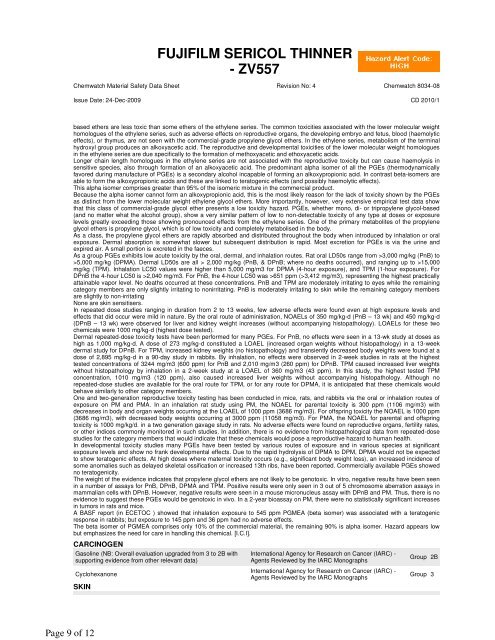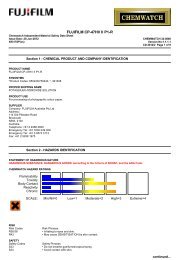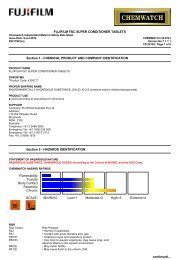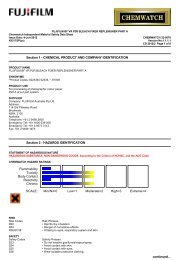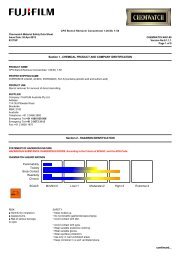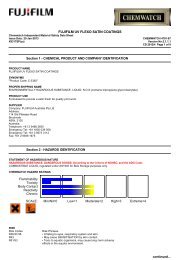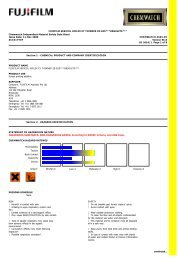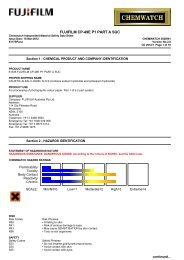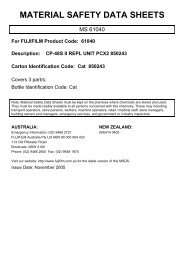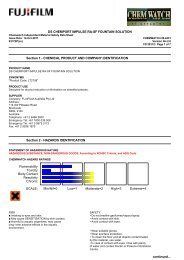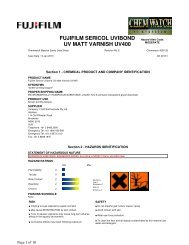FUJIFILM SERICOL THINNER - ZV557 - FUJIFILM Australia
FUJIFILM SERICOL THINNER - ZV557 - FUJIFILM Australia
FUJIFILM SERICOL THINNER - ZV557 - FUJIFILM Australia
You also want an ePaper? Increase the reach of your titles
YUMPU automatically turns print PDFs into web optimized ePapers that Google loves.
<strong>FUJIFILM</strong> <strong>SERICOL</strong> <strong>THINNER</strong>- <strong>ZV557</strong>Chemwatch Material Safety Data Sheet Revision No: 4 Chemwatch 8034-08Issue Date: 24-Dec-2009 CD 2010/1based ethers are less toxic than some ethers of the ethylene series. The common toxicities associated with the lower molecular weighthomologues of the ethylene series, such as adverse effects on reproductive organs, the developing embryo and fetus, blood (haemolyticeffects), or thymus, are not seen with the commercial-grade propylene glycol ethers. In the ethylene series, metabolism of the terminalhydroxyl group produces an alkoxyacetic acid. The reproductive and developmental toxicities of the lower molecular weight homologuesin the ethylene series are due specifically to the formation of methoxyacetic and ethoxyacetic acids.Longer chain length homologues in the ethylene series are not associated with the reproductive toxicity but can cause haemolysis insensitive species, also through formation of an alkoxyacetic acid. The predominant alpha isomer of all the PGEs (thermodynamicallyfavored during manufacture of PGEs) is a secondary alcohol incapable of forming an alkoxypropionic acid. In contrast beta-isomers areable to form the alkoxypropionic acids and these are linked to teratogenic effects (and possibly haemolytic effects).This alpha isomer comprises greater than 95% of the isomeric mixture in the commercial product.Because the alpha isomer cannot form an alkoxypropionic acid, this is the most likely reason for the lack of toxicity shown by the PGEsas distinct from the lower molecular weight ethylene glycol ethers. More importantly, however, very extensive empirical test data showthat this class of commercial-grade glycol ether presents a low toxicity hazard. PGEs, whether mono, di- or tripropylene glycol-based(and no matter what the alcohol group), show a very similar pattern of low to non-detectable toxicity of any type at doses or exposurelevels greatly exceeding those showing pronounced effects from the ethylene series. One of the primary metabolites of the propyleneglycol ethers is propylene glycol, which is of low toxicity and completely metabolised in the body.As a class, the propylene glycol ethers are rapidly absorbed and distributed throughout the body when introduced by inhalation or oralexposure. Dermal absorption is somewhat slower but subsequent distribution is rapid. Most excretion for PGEs is via the urine andexpired air. A small portion is excreted in the faeces.As a group PGEs exhibits low acute toxicity by the oral, dermal, and inhalation routes. Rat oral LD50s range from >3,000 mg/kg (PnB) to>5,000 mg/kg (DPMA). Dermal LD50s are all > 2,000 mg/kg (PnB, & DPnB; where no deaths occurred), and ranging up to >15,000mg/kg (TPM). Inhalation LC50 values were higher than 5,000 mg/m3 for DPMA (4-hour exposure), and TPM (1-hour exposure). ForDPnB the 4-hour LC50 is >2,040 mg/m3. For PnB, the 4-hour LC50 was >651 ppm (>3,412 mg/m3), representing the highest practicallyattainable vapor level. No deaths occurred at these concentrations. PnB and TPM are moderately irritating to eyes while the remainingcategory members are only slightly irritating to nonirritating. PnB is moderately irritating to skin while the remaining category membersare slightly to non-irritatingNone are skin sensitisers.In repeated dose studies ranging in duration from 2 to 13 weeks, few adverse effects were found even at high exposure levels andeffects that did occur were mild in nature. By the oral route of administration, NOAELs of 350 mg/kg-d (PnB – 13 wk) and 450 mg/kg-d(DPnB – 13 wk) were observed for liver and kidney weight increases (without accompanying histopathology). LOAELs for these twochemicals were 1000 mg/kg-d (highest dose tested).Dermal repeated-dose toxicity tests have been performed for many PGEs. For PnB, no effects were seen in a 13-wk study at doses ashigh as 1,000 mg/kg-d. A dose of 273 mg/kg-d constituted a LOAEL (increased organ weights without histopathology) in a 13-weekdermal study for DPnB. For TPM, increased kidney weights (no histopathology) and transiently decreased body weights were found at adose of 2,895 mg/kg-d in a 90-day study in rabbits. By inhalation, no effects were observed in 2-week studies in rats at the highesttested concentrations of 3244 mg/m3 (600 ppm) for PnB and 2,010 mg/m3 (260 ppm) for DPnB. TPM caused increased liver weightswithout histopathology by inhalation in a 2-week study at a LOAEL of 360 mg/m3 (43 ppm). In this study, the highest tested TPMconcentration, 1010 mg/m3 (120 ppm), also caused increased liver weights without accompanying histopathology. Although norepeated-dose studies are available for the oral route for TPM, or for any route for DPMA, it is anticipated that these chemicals wouldbehave similarly to other category members.One and two-generation reproductive toxicity testing has been conducted in mice, rats, and rabbits via the oral or inhalation routes ofexposure on PM and PMA. In an inhalation rat study using PM, the NOAEL for parental toxicity is 300 ppm (1106 mg/m3) withdecreases in body and organ weights occurring at the LOAEL of 1000 ppm (3686 mg/m3). For offspring toxicity the NOAEL is 1000 ppm(3686 mg/m3), with decreased body weights occurring at 3000 ppm (11058 mg/m3). For PMA, the NOAEL for parental and offspringtoxicity is 1000 mg/kg/d. in a two generation gavage study in rats. No adverse effects were found on reproductive organs, fertility rates,or other indices commonly monitored in such studies. In addition, there is no evidence from histopathological data from repeated-dosestudies for the category members that would indicate that these chemicals would pose a reproductive hazard to human health.In developmental toxicity studies many PGEs have been tested by various routes of exposure and in various species at significantexposure levels and show no frank developmental effects. Due to the rapid hydrolysis of DPMA to DPM, DPMA would not be expectedto show teratogenic effects. At high doses where maternal toxicity occurs (e.g., significant body weight loss), an increased incidence ofsome anomalies such as delayed skeletal ossification or increased 13th ribs, have been reported. Commercially available PGEs showedno teratogenicity.The weight of the evidence indicates that propylene glycol ethers are not likely to be genotoxic. In vitro, negative results have been seenin a number of assays for PnB, DPnB, DPMA and TPM. Positive results were only seen in 3 out of 5 chromosome aberration assays inmammalian cells with DPnB. However, negative results were seen in a mouse micronucleus assay with DPnB and PM. Thus, there is noevidence to suggest these PGEs would be genotoxic in vivo. In a 2-year bioassay on PM, there were no statistically significant increasesin tumors in rats and mice.A BASF report (in ECETOC ) showed that inhalation exposure to 545 ppm PGMEA (beta isomer) was associated with a teratogenicresponse in rabbits; but exposure to 145 ppm and 36 ppm had no adverse effects.The beta isomer of PGMEA comprises only 10% of the commercial material, the remaining 90% is alpha isomer. Hazard appears lowbut emphasizes the need for care in handling this chemical. [I.C.I].CARCINOGENGasoline (NB: Overall evaluation upgraded from 3 to 2B withsupporting evidence from other relevant data)CyclohexanoneSKINInternational Agency for Research on Cancer (IARC) -Agents Reviewed by the IARC MonographsInternational Agency for Research on Cancer (IARC) -Agents Reviewed by the IARC MonographsGroup 2BGroup 3Page 9 of 12


